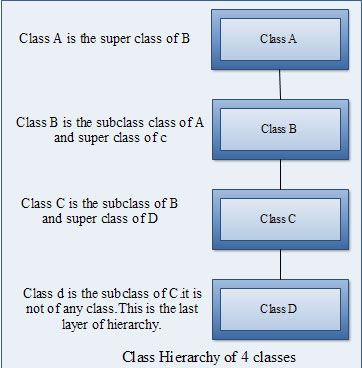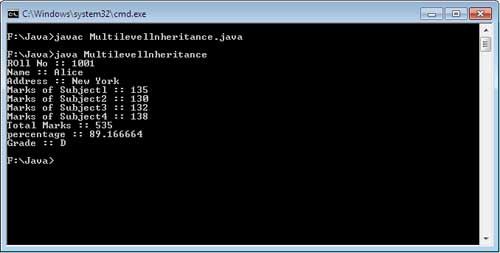Java supports multilevel inheritance. In multiple, multilevel class hierarchies contain the layers of inheritance. But at each layer, a class is a subclass of the superc1ass of another, except the last layer. One pictorial representation of such concept is given below.

Example:
class Student
{
private int rollno;
private String name;
private String address;
public void storeDetails(int rno, String sname, String sadd)
{
rollno = rno;
name = sname;
address = sadd;
}
public void showDetails()
{
System.out.println(“ROll No :: ” + rollno);
System.out.println(“Name :: ” + name);
System.out.println(“Address :: ” + address);
}
}
class Test extends Student
{
protected int marksSubjectl;
protected int marksSubject2;
protected int marksSubject3;
protected int marksSubject4;
public void storeMarks(int ml, int m2, int m3, int m4)
{
marksSubjectl = ml;
marksSubject2 = m2;
marksSubject3 = m3;
marksSubject4 = m4;
}
public void showMarks()
{
System.out.println(“Marks of Subjectl :: ” + marksSubjectl);
System.out.println(“Marks of Subject2 :: ” + marksSubject2);
System.out.println(“Marks of Subject3 :: ” + marksSubject3);
System.out.println(“Marks of Subject4 :: ” + marksSubject4);
}
}
class Result extends Test
{
private int totalMarks;
private float percentage;
private char grade;
public void evaluateResult()
{
totalMarks = marksSubjectl + marksSubject2 + marksSubject3 + marksSubject4;
percentage = (totalMarks*100.00F/600.00F);
if (percentage >=50.00F)
grade=’D’;
else
if(percentage >=55.00F && percentage<=60.00F)
grade = ‘C’;
else
if (percentage >=61.00F && percentage<=70.00F)
grade = ‘B’;
else
if (percentage >=71.00F && percentage<=75.00F)
grade = ‘A’;
else
if (percentage >=76.00F && percentage<=85.00F)
grade = ‘H’;
else
grade = ‘S’;
}
public void showResult()
{
showDetails();
showMarks();
System.out.println(“Total Marks :: ” + totalMarks);
System.out.println(“percentage :: ” + percentage);
System.out.println(“Grade :: ” + grade);
}
}
public class Multilevellnheritance
{
public static void main(String ar[])
{
Result ob = new Result();
ob.storeDetails(1001, “Alice”, “New York”);
ob.storeMarks(135,130,132,138);
ob.evaluateResult();
ob.showResult();
}
}
output

There can be few problems in multilevel inheritance, if the classes are not properly designed by the designer, or proper keywords art\ not used.
- How the superclass parameterized constructor will be called?
- If superclass and subclass protected or public data members have same name then, superclass data member will be hidden. How to distinguish or to access the superclass data member in the subclass?
- If subclass member methods have the same signature as the superclass member method then how to call the superclass member methods?
The super keyword is the solution of all the above problems, to refer to its immediate superclass. The super has two general forms as given below:
- To call the superclass constructor
- To access the hidden member of the superclass.
Example:
class Student
{
private int rollno;
private String name;
private String address;
public void storeDetails(int rno, String sname, String sadd)
{
rollno = rno;
name = sname;
address = sadd;
}
public void show()
{
System.out.println(“ROll No :: ” + rollno);
System.out.println(“Name :: ” + name);
system.out.println(“Address :: ” + address);
}
}
class Test extends Student
{
protected int marksSubjectl;
protected int marksSubject2;
protected int marksSubject3;
protected int marksSubject4;
public void test (int rno, String sname, String sadd,int ml, int m2, int m3, int m4)
{
super(rno,sname,sadd);
marksSubjectl = ml;
marksSubject2 = m2;
marksSubject3 = m3;
marksSubject4 m4;
}
public void show()
{
super.show();
System.out.println(“Marks of Subjectl :: ” + marksSubjectl);
System.out.println(“Marks of Subject2 :: ” + marksSubject2);
System.out.println(“Marks of Subject3 :: ” + marksSubject3);
System.out.println(“Marks of Subject4 :: ” + marksSubject4);
}
class Result extends Test
{
private int totalMarks;
private float percentage;
private char grade;
public void Result(int rno, String sname, String sadd,int ml, int m2, int m3, int m4)
{
super(rno,sname,sadd,ml,m2,m3,m4);
totalMarks = marksSubjectl + marksSubject2 + marksSubject3 + marksSubject4;
percentage = (totalMarks*100.00F/600.00F);
if (percentage >=50.00F)
grade=’D’;
else
if(percentage >=55.00F && percentage<=60.00F)
grade = ‘C’;
else
if (percentage >=61.00F && percentage<=70.00F)
grade = ‘B’;
else ,
if (percentage >=71.00F && percentage<=75.00F)
grade = ‘A’;
else
if (percentage >=76.00F && percentage<=85.00F)
grade = ‘H’;
else
grade = ‘S’;
}
public void show()
{
super.show();
System.out.println(“Total Marks :: ” + totalMarks);
System.out.println(“percentage :: ” + percentage);
System.out.println(“Grade :: ” + grade);
}
}
public class MultilevellnheritanceDemo2
{
public static void main(String arg[])
{
Result ob = new Result (1001, “Alice”, “New York“, 135,130,132,138);
ob.show ();
}
The above code show how to call the superclass constructor and how to call the superclass method if that signature is same as the subclass method signature.
Example:
class Abc
{
int i;
public Abc(int i)
{
this.i= i;
}
}
class Xyz extends Abc
{
int i,j;
public Xyz(int a,int b)
{
super(a);
j=b;
i = ++(super.i);
}
public void showAll()
{
System.out.println(“Superclass ‘i’ :: “+super.i);
System.out.println(“Subclass ‘i’ :: ” + i +” ‘j’ :: “+ j);
}
}
public class MultilevellnheritanceDemo
{
public static void main(String arg[])
{
Xyz ob = new Xyz(1,2);
ob.showAll();
} }
Output:.
Superclass ‘i’ :: 2
Subclass ‘i’ :: 2 ‘j’:: 2
In the above code, in subclass the data member of superclass ‘i’ hides with subclass data member ‘i’, so that using super keyword it access .
 Dinesh Thakur holds an B.C.A, MCDBA, MCSD certifications. Dinesh authors the hugely popular
Dinesh Thakur holds an B.C.A, MCDBA, MCSD certifications. Dinesh authors the hugely popular